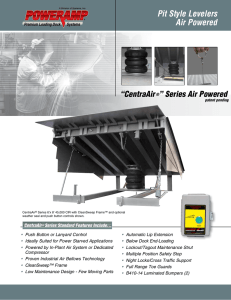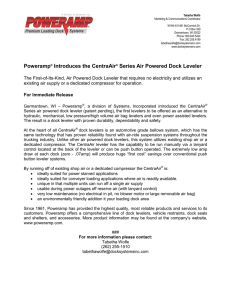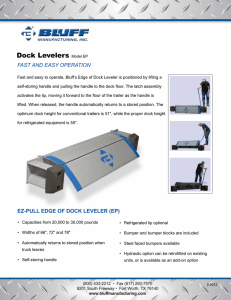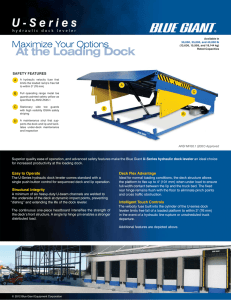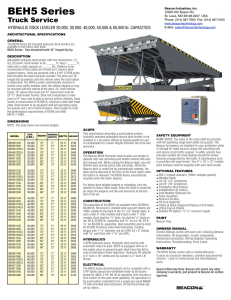Hydraulic Dock Leveler
advertisement
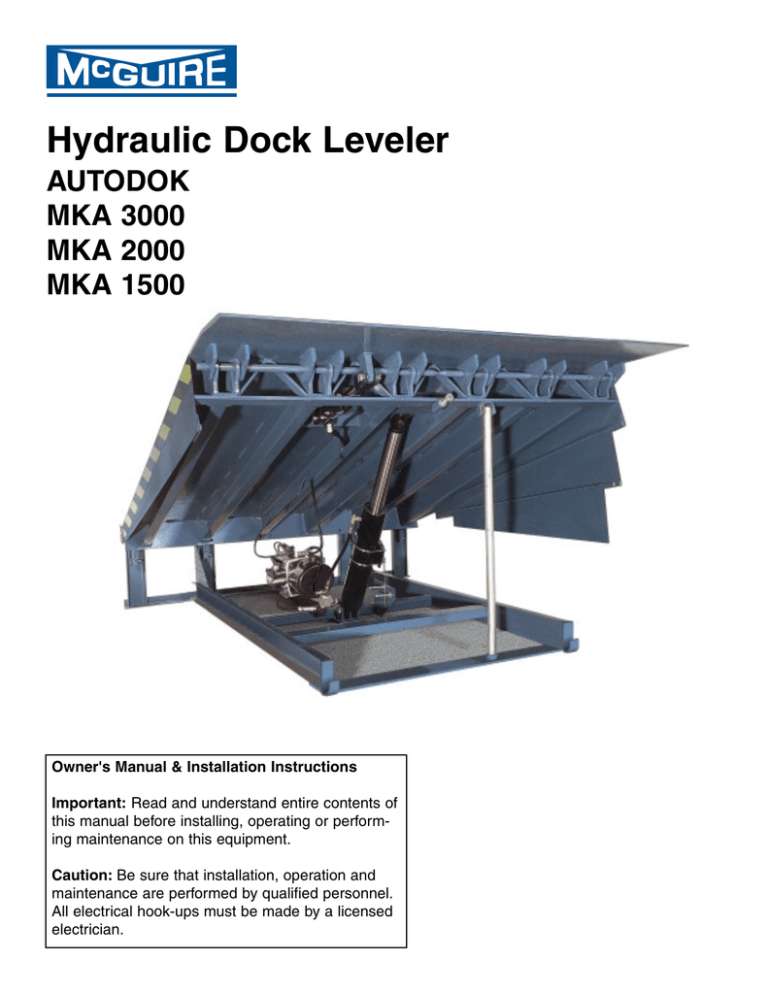
Hydraulic Dock Leveler AUTODOK MKA 3000 MKA 2000 MKA 1500 Owner's Manual & Installation Instructions Important: Read and understand entire contents of this manual before installing, operating or performing maintenance on this equipment. Caution: Be sure that installation, operation and maintenance are performed by qualified personnel. All electrical hook-ups must be made by a licensed electrician. TABLE OF CONTENTS Introduction ........................................................................................................................................... 1 Overview of Potential Hazards ............................................................................................................ 2 Definition & Function-, Safety Practices .............................................................................................. 3 Installation Instructions ...................................................................................................................... 4-5 Pit Detail & Dimensions ........................................................................................................................ 6 Shim Location Diagram ........................................................................................................................ 7 Electrical Schematics ...................................................................................................................... 8-11 Dock Bumper Mounting ...................................................................................................................... 12 Operation Instructions ................................................................................................................... 13-14 Setting the Inspection Leg .................................................................................................................. 15 Maintenance & Service .......................................................................................................................16 Trouble Shooting Procedures ............................................................................................................. 18 Control Valves & Motor Pump Adjustments ....................................................................................... 19 Switch Arrangements ......................................................................................................................... 20 Hydraulic System View & Parts List .................................................................................................. 21 Control Panel View & Parts List ........................................................................................................ 22 Warranty .............................................................................................................................. Back Cover INTRODUCTION Congratulations! You have just purchased one of the industry's finest hydraulically operated dock levelers from the W.B. McGuire Company Inc. of Hudson, NY When properly installed, operated and serviced, this leveler can offer substantial efficiency and productivity. This McGuire hydraulic dock leveler is the result of many skilled workers and its design, manufacture, and full hydraulic operation are regarded with pride by the W.B. McGuire Company, Inc. This hydraulic dock leveler by McGuire is designed to improve safety and efficiency for personnel involved in shipping and receiving goods at the loading dock area. Improved safety conditions are achieved by use of the control panel to operate the dock leveler. This reduces the risk of injury by keeping personnel off of the leveler and eliminates the unhealthy practice of manually positioning the leveler. Efficiency is the result of quicker operation, and a more reliable hydraulic operating system. This system requires minimal maintenance and provides you with years of dependable service. All safety considerations should be observed by all those who install, operate and service this equipment. Even well-built products can be installed, operated and serviced in a less than safe manner. Read this manual completely through to understand all installation, operation and maintenance instructions and functions before attempting to install, operate or service this hydraulic dock leveler. Pay special attention to all warnings and/or caution statements. 1 OVERVIEW OF POTENTIAL HAZARDS... ! WARNING Moving Ramp can cause serious injury or death. Stay Clear when ramp is in motion. Moving Leveler Do Not enter pit area until ramp has been braced open and power is turned off and locked out. Moving Truck can cause serious injury or death. Stay Clear when truck is in motion. Moving Truck Do Not stand between truck and ramp when truck is entering or leaving. Electrical Shock can cause serious injury or death. Turn Power Off before touching wires or working in box. Moving Shock If no power disconnect is provided, station a second person by the control panel to insure no unauthorized use. SAFETY INSTRUCTIONS 1. Read manual carefully before installing, operating, or servicing dock leveler. 2. Be sure truck wheels are chocked or truck is held in place by a restraining device before loading or unloading. 3. Make sure leveler is returned to its level, stored position after truck pulls away from dock. 4. Do not attempt to manually lift the dock leveler platform or lip. Do Not operate leveler with equipment, material or people on the platform, lip or in front of the leveler. 5. Keep pedestrians and forklifts away from open door area when not loading or unloading truck. 6. If dock leveler appears to be broken or is not working properly, contact your authorized McGuire representative. In the following sections the word: Danger means that serious injury or death will occur from failure to follow instructions. Warning means that serious injury or death can occur from failure to follow instructions. Caution means that minor injury or property damage can occur from failure to follow instructions. Note means that special attention should be given to the instruction. 2 DEFINITION AND FUNCTION The McGuire hydraulic dock leveler is designed for both structural integrity in operation and safety features for the protection of dock personnel. Its function is to provide a safe and durable bridge between the building and the trailer. This bridge allows the safe transportation of material handling devices (i.e. fork truck, pallet jack, hand truck) and workers for the purpose of loading and unloading the trailer. All McGuire hydraulic levelers are equipped with a velocity fuse "Fail-Safe" system which automatically halts all motion of the platform, within 1 " to 3", if a truck prematurely departs with a load on the platform. Other safety features include full-range toe guards that are safety marked, a built-in service leg support and an automatic night lock feature to aid in the prevention of possible break-in attempts through the dock area. The leveler is push button operated from a wall mount control panel and is fully electro-hydraulic operated. Models can be equipped with an Emergency Stop button which halts all movement of the leveler at any point during the cycle. A selector switch on the control panel allows automatic positiong for below dock end load situations. The unit is powered by a 1 horsepower single or polyphase electric motor with manifold block and a reservoir that is directly coupled to the motor via the manifold block. The main lift cylinder raises and lowers the platform. The lip cylinder extends, supports and retracts the lip. Flexible hosing connects both cylinders to the power unit. Electrical leads from motor/pump and integral control switches are factory wired, ready to hook up to leads in the junction box at the rear of the pit. The control panel is wired to work in conjunction with the motor/pump. Connections between terminals in the control panel and the pit junction box are not furnished by McGuire. This must be done prior to installing this hydraulic leveler. Connections between terminals in the control panel and the main power line are also not furnished by McGuire. SAFETY PRACTICES 1. Do not operate this equipment while under the influence of drugs or alcohol. 2. Do not stand in the driveway between the leveler and a moving truck. 3. Be sure that the trailer wheels are chocked or restraint device is positioned. 4. Do not use the leveler if appears to be broken or operating improperly. 5. Do not operate the leveler with equipment, material or people on the platform. 6. Be certain that nothing is on the leveler while a truck pulls away from the dock. 7. Keep all limbs clear of the leveler while it is in motion. 8. Do not attempt to manually lift the leveler platform. 9. Always make sure the leveler has been returned to the dock level (stored) position. 10. Never work under the dock leveler without proper placement of the service leg. 11. When servicing leveler, disconnect power and tag control panel "Out of Service." Place a barrier on grade level in front of the leveler to prevent any truck from backing to the dock. Contact the McGuire Technical Support Team at 1-800-624-8473 if you have any questions or do not understand any material presented in this manual. 3 INSTALLATION INSTRUCTIONS CAUTION: Installation must be performed by qualified personnel ONLY. WARNING: Always support the leveler platform with suitable braces. NEVER work under the leveler without properly supporting the platform. Equipment Check: 1. Check the leveler for any possible damage that may have occurred during transportation. DO NOT INSTALL A DAMAGED LEVELER. Check that the control panel and bumpers are present. Report any damage immediately to your supervisor. Pit Check 2. 3. Check the pit for proper construction. Clean out any debris. Check the pit walls to make sure they are square and plumb. Measure the pit dimensions to make sure they match the leveler dimensions. DO NOT INSTALL THE LEVELER IF THE PIT IS NOT FORMED CORRECTLY. Control Panel 4. Unband the control panel and mount it to the wall where the electrical leads will meet it. A licensed electrician can now connect the control panel to the main power lead in and pull the proper leads through conduit and into the junction box at the rear of the pit. Refer to the proper wiring diagrams (pages 8-11 ) for proper connection. NOTE.- Factory recommendation is for motor leads to extend from junction box for temporary power source. Installation of Leveler and Bumpers 5. Move the leveler with a fork truck using the built-in fork slots in the front base frame. Position the leveler so that the rear frame is approximately 36" from the rear of the pit. 6. A licensed electrician can now connect the temporary extended motor leads from the junction box to leads in the rubber covered cable from the leveler motor. Refer to wiring diagram, page 7. Back the fork truck out approximately 24" but keep forks in the slots. Check for proper wiring by operating the leveler. (See Operation Instructions, pages 13-14). NOTE- On three phase current, check for proper motor rotation per wiring diagram. If leveler does not raise when pump is energized, the rotation is wrong. Correct by reversing two power leads to motor. 8. Once proper operation is achieved, move the leveler to within 12" from the rear of the pit. The licensed electrician can now make permanent wiring hook-ups and close the junction box. WARNING: DO NOT enter pit area until leveler has been braced open with jack stands. 4 INSTALLATION INSTRUCTIONS (continued) 9. Position the leveler so that there is 1 " of clearance on both sides. Push the leveler all the way into the pit, so that the rear frame of the leveler is flush and tight against the rear curb angle of the pit. Tack weld the leveler to the rear curb angle of the pit at both sides. 10. The fork truck can be removed from the area. Operate the leveler using the control panel. Raise the platform to its highest position and let the lip extend. 11. Set the built-in inspection leg to help support the platform. The leveler should be sup ported by suitable braces. 12. Place shims under weight transfer points. See shim location diagram, page The leveler may have to be stored to check for proper height. The platform should be level with the dock floor when in stored position. Add or remove shims to make level. 13. Cycle leveler through 5 complete cycles. 14. When all shims are in place and leveler is level with dock floor, finishing welding the leveler rear angle to the curb angle. 15. Weld shims together and to the base frame of the leveler. At the front, weld shims together, to the leveler base frame and to the front curb angle of the pit floor. 16. Spot paint front shims and rear angle. 17. Check all hydraulic hoses and fittings for integrity and tightness. 18. Operate leveler and store service leg. Allow leveler to return to stored position , flush with dock floor. 19. Mount the bumpers to the dock face using suitable fasteners. Bumpers should be at least 48" from grade measuring to the top of the bumper, and flush with the dock floor. Mount the inside edge of the bumper flush with the pit side wall. CAUTION: If the dock floor line is lower than 48", adequate bracing behind the bumpers is required to maintain the 48" height requirement. Contact factory for specific details. 20. Operate the leveler through several complete cycles. Check for consistent operation. Check the below dock capability. Check the emergency stop and independent lip control, if equipped. IF THE LEVELER DOES NOT OPERATE PROPERLY, DO NOT USE LEVELER. CONTACT McGUIRE IMMEDIATELY. 21. Have an official of your company at the site to review the proper operation and installation of the dock leveler and sign off the warranty card. 5 PIT DETAILS AND DIMENSIONS... NOTE: 3" x 3' x 1/4" steel curb angle part 1, 2, 3, & 4 by others. Available by W.B. McGuire Co. at additional cost. Angles must be 1/2” diameter x 6” long steel anchors at 12” max. centers. 6 SHIM LOCATION DIAGRAM NOTE: The diagram below shows required shim positions to provide proper weight transfer to pit floor. Shims should be various thicknesses of mild, hot rolled steel. All shims must be tight under frame, and a minimum of 4"x 4"plate steel. Weld shims in place to assure against movement. Weld shims together and to leveler base frame as described in the Installation Instructions. 7 ELECTRICAL SCHEMATICS 8 ELECTRICAL SCHEMATICS 9 ELECTRICAL SCHEMATICS 10 ELECTRICAL SCHEMATICS 11 DOCK BUMPER TYPES & MOUNTING INSTRUCTIONS 12 OPERATION INSTRUCTIONS CAUTION: Be sure that truck wheels are chocked or a restraint device is intact NOTE- This example control panel is equipped with Emergency Stop and Independent Lip buttons. This is optional equipment, not standard. MIKA 2000 & MIKA 3000 standard control panels have only the Operate button and Normal/Below Dock selector switch. MIKA 1500 control panels have an operate button only. Emergency Stop and Independent Lip operations are covered at the end of this section. Example McGuire control panel. NORMAL SETTING ON SELECTOR SWITCH Loading or unloading with no end load situation. 1. Once the truck has backed against the bumpers, and the wheels have been chocked or a restraint activated, press and hold the OPERATE button on the control panel until the platform has raised to the top of its cycle and the lip has been extended. 2. When the lip has fully extended, release the OPERATE button. The platform will lower smoothly until the lip rests on the truck bed. 3. The leveler will automatically float freely with the rise and fall of the truck bed in either the loading or unloading cycle. 4. When the truck departs, and the lip becomes unsupported, the leveler will settle to its fully lowered position. The motor will automatically restart, the leveler will raise just enough to let the lip fall pendant, and the motor will then automatically shut off. The leveler will settle into its stored position. BELOW DOCK SETTING ON SELECTOR SWITCH Loading or unloading with an end load situation' 1. Once the truck has backed against the bumpers, and the wheels have been chocked or a restraint activated, press and hold the OPERATE button on the control panel until the platform has raised to the top of its cycle. The lip will extend far enough to clear the lip keepers. The motor will automatically shut off and the leveler will smoothly settle into its fully lowered position. 2. When loading or unloading the end load is finished, return the leveler to the stored, cross traffic position. If the loading or unloading process needs to be finished under normal operating circumstances, repeat the steps used under NORMAL SETTING. WARNING: Stay Clear when leveler or truck is in motion. Do Not stand between truck and leveler when truck is entering or leaving. 13 OPERATION INSTRUCTIONS CONTINUED OPERATION WITH EXTREMELY LOW TRUCK BEDS These instructions are intended to be followed when it is necessary to service extremely low trucks with no end load and the lip must be extended. 1. Once the truck has backed against the bumpers, and the wheels have been chocked or a restraint activated, set the selector switch to NORMAL, press and hold the OPERATE button until the platform rises to the top of its cycle and the lip has extended. 2. When the leveler lip has fully extended, release the OPERATE button. The deck will start to lower with lip extended. Turn the selector switch to BELOW DOCK. The leveler will settle to its fully lowered position with the lip fully extended. 3. When loading or unloading is finished, return the leveler to the stored, cross traffic position. STORING THE LEVELER WITH A TRUCK AT THE DOCK 1. The leveler will be positioned on the bed of the truck. 2. With the selector switch in the NORMAL position, press and hold the OPERATE button. 3. As the leveler begins to rise, the lip will fall pendant. At this point, release the OPERATE button and the leveler will return to the stored, cross traffic position. INDEPENDENT LIP OPERATION (IF EQUIPPED) 1. Once the truck has backed against the bumpers, and the wheels have been chocked or a restraint activated, set selector switch to NORMAL. Press and hold the OPERATE button. When the leveler has reached the desired position, release the OPERATE button and immediately press and hold the LIP EXTEND button. 2. Once the lip has fully extended, release the LIP EXTEND button and deck will settle on to truck bed with lip extended. EMERGENCY STOP (IF EQUIPPED) 1. The EMERGENCY STOP button can be pushed at any point of the leveler's cycle to immediately halt any and all movement of the leveler. Pull the button out to resume action. 14 OPERATION INSTRUCTIONS CONTINUED OPERATION WITH EXTREMELY LOW TRUCK BEDS These instructions are intended to be followed when it is necessary to service extremely low trucks with no end load and the lip must be extended. 1. Once the truck has backed against the bumpers, and the wheels have been chocked or a restraint activated, set the selector switch to NORMAL, press and hold the OPERATE button until the platform rises to the top of its cycle and the lip has extended. 2. When the leveler lip has fully extended, release the OPERATE button. The deck will start to lower with lip extended. Turn the selector switch to BELOW DOCK. The leveler will settle to its fully lowered position with the lip fully extended. 3. When loading or unloading is finished, return the leveler to the stored, cross traffic position. STORING THE LEVELER WITH A TRUCK AT THE DOCK 1. The leveler will be positioned on the bed of the truck. 2. With the selector switch in the NORMAL position, press and hold the OPERATE button. 3. As the leveler begins to rise, the lip will fall pendant. At this point, release the OPERATE button and the leveler will return to the stored, cross traffic position. INDEPENDENT LIP OPERATION (IF EQUIPPED) 1. Once the truck has backed against the bumpers, and the wheels have been chocked or a restraint activated, set selector switch to NORMAL. Press and hold the OPERATE button. When the leveler has reached the desired position release the OPERATE button and immediately press and hold the LIP EXTEND button. 2. Once the lip has fully extended, release the LIP EXTEND button and deck will settle on to truck bed with lip extended. EMERGENCY STOP (IF EQUIPPED) 1. The EMERGENCY STOP button can be pushed at any point of the leveler's cycle to immediately halt any and all movement of the leveler. Pull the button out to resume action. 14 SETTING THE BUILT-IN INSPECTION LEG The inspection leg is a built-in steel pipe which, when set in place properly, will support the platform in an upright position. For qualified personnel to perform maintenance or service, the platform should be supported with adequate bracing. Setting the inspection leg requires two people. CAUTION: The inspection leg is meant to support the weight of the platform only, 1. Tag the control panel "Out of Service'' to prevent accidental operation of the leveler. 2. Place barriers on grade level in front of the leveler to prevent trucks from backing to the dock. 3. Have one attendant raise the leveler platform using the OPERATE button. Keep the button depressed until the second attendant gives the "OK" to release. 4. The second attendant can unhook the inspection leg and set it in its vertical position. Once set, the second attendant can give the "OK" and the first attendant can release the OPERATE button. As an additional safety measure, press the EMERGENCY STOP button (if equipped) to cut all power to the leveler. To store the inspection leg, pull the EMERGENCY STOP button (if equipped), press and hold the OPERATE button until the platform rises to the top of its cycle and the lip is fully extended. Keep the button depressed until the second attendant gives the "OK" to release. 5. 6. The second attendant can re-hook the inspection leg to its stored position. Once set, the second attendant can give the "OK" and the first attendant can release the OPERATE button. The leveler will return to the stored, cross traffic position. NOTE: NEVER WORK UNDER THE LEVELER WITHOUT PROPERLY SUPPORTING THE PLATFORM WITH ADEQUATE BRACES. DO NOT PUT ANYTHING ON THE LEVELER PLATFORM WHILE THE INSPECTION LEG IS SUPPORTING THE PLATFORM. MAKE SURE CO-WORKERS KNOW NOT TO OPERATE THE LEVELER WHILE MAINTENANCE OR SERVICE IS BEING PERFORMED. WARNING: DO NOT enter pit area until leveler has been braced open with jack stands. 15 MAINTENANCE AND SERVICE WARNING: DO NOT enter pit area until leveler has been braced open with jack stands. On-site maintenance personnel can observe the following procedures or you can arrange for professional service through your authorized McGuire representative. The frequency of maintenance and service required will vary due to the amount and type of usage. Contact your authorized McGuire representative of the factory for information. Authorization to repair, replace or otherwise adjust any portion of the dock leveler should always be secured in advance of any work taking place. Failure to do so could VOID the dock leveler warranty. 1. Follow the procedures for Setting the Built-in Inspection Leg. 2. Clean any debris from the pit. Clear the hinge areas of any collected debris. During winter months in cold climate, remove any ice formed on moving parts. 3. Inspect the condition of lip, platform, subframe and all welds for wear and/or damage. Report any deficiencies immediately. If in doubt, report it! 4. Check conditions of front and rear hinges. Report any deficiencies. 5. Check the fluid level in the motor/pump reservoir using the dipstick on the breather cap. If necessary, add proper fluid. Replace the breather cap. 6. Check integrity of ail hydraulic hoses and fittings for tightness. Replace or tighten as needed. 7. Inspect all hydraulic cylinders and switches for damage or wear. Replace as required. 8. Inspect and lubricate all cylinder pivots. 9. Check weatherseals for damage or signs of wear. Replace as required. 10. Inspect toe guards for damage. Replace as required. 11. Inspect all electrical connections and wiring for signs of wear or damage. Report any deficiencies. Have only a licensed electrician make repairs. 12. Check safety tape markings. Replace as required. 13. Check all labels and warnings. Replace as required. 14. Inspect bumpers for wear. Check fasteners. Tighten, or replace as required. 15. Follow the instructions for storing the service leg. 16. Once leveler is returned to the stored position, operate the leveler following the Operation Instructions. Run the leveler through several complete cycles. IF LEVELER IS NOT OPERATING PROPERLY, DO NOT USE THE LEVELER. CONTACT YOUR AUTHORIZED REPRESENTATIVE OR THE FACTORY IMMEDIATELY. 16 TROUBLE SHOOTING PROCEDURES If the corrective action does not solve the problem, consult the McGuire Technical Support Team immediately. DO NOT USE THE LEVELER. If you encounter a problem that is not covered under this section, consult the McGuire Technical Support Team immediately at 1-800-624-8473. SYMPTON 1. Leveler will not rise. Motor not running. 2. Leveler will not rise. Motor running or humming. Motor starts then stops. POSSIBLE CAUSE CORRECTIVE ACTION A. Incorrect or disconnected electrical hookup. A. Review wiring diagram and check connections. B. Blown fuses or open circuit breakers in building. B. Check fuses and replace or reset circuit breakers. Determine and correct cause of electrical problems. C. Loss of line voltage. C. Check line and repair as necessary. D. Open overload relays on leveler motor starter. D. Allow to cool and reset by pushing in reset button at the thermal overload in control panel. E. Burned out motor in leveler motor/pump. E. Replace power unit (contact factory) or have electrical shop repair motor. A. If motor humming (1 phase current), voltage drop. May be due to insufficient line capacity. A. Test voltage at motor starter with motor running. Also test for amperage draw. Low voltage/high amperage indicates wire gauge is too light for distance of run. Replace feed line with adequate wire size. B. Wrong rotation of 3-phase motor. B. Reverse T1 & T3 hookup at starter terminal. C. Motor is single phasing on 3-phase current. C. Check line fuse or other loss of power in one line. (Loose connection or tripped overload at starter.) 17 TROUBLE SHOOTING PROCEDURES CONTINUED SYMPTON POSSIBLE CAUSE CORRECTIVE ACTION D. Load on leveler. D. Remove load to operate leveler. Leveler is not designed to lift more than its own weight. E. Low fluid or no fluid. E. Check fluid level and fill as required. Determine and correct cause of fluid loss. F. Motor pump is ph sically or electrically damaged. F. Replace motor/pump. G. Overloaded main circuit. G. Check current draw. A. Physical obstruction. A. Remove obstruction. B. In "Fail-Safe" lockup. B. Actuate the OPERATE button momentarily to unlock the "FailSafe" system. 4. Leveler continues to "lockup" after each actuation of OPERATE button. A. Ramp lowering speed is too high. A. Adjust shuttle valve on motor/pump to reduce ramp lowering speed. 5. Leveler will not automatically return from below dock position. (Not automatic on MKA 1500 series levelers.) A. Selector switch is in BELOW DOCK mode. A. Change selector switch to NORMAL mode. B. Return switch arm has not engaged the tripper bolt. B. Adjust tripper bolt to correct adjustment to trip return switch. C. Return switch arm may be out of adjustment or damaged C. Properly position return switch arm or replace if required. D. Incorrect wiring or loose. D. Check wiring/connections. A. Lip switch arm may be out of adjustment or damaged. A. Adjust arm or replace. B. Incorrect or loose wire. B. Check wiring/connections. A. Valve maybe clogged. A. See lip adjustment section. B. Secondary Relief Valve out of adjustment. B. Adjust valve correctly. C. Low voltage - more often occurs on 1 ph motors. C. Check draw during operation. Use alternate line. D. Low fluid. D. Check level and fill. A. Sequence Valve set too low. A. Adjust sequence valve so lip extends when dock is fully open. 3. Leveler will not lower. Lip is extended. 6. Leveler will not rise. Selector switch in BELOW DOCK position. 7. Lip will not hold out; lip sag occurs. 8. Lip extends too soon. 18 CONTROL VALVES AND MOTOR PUMP ADJUSTMENT McGuire hydraulic levelers are shipped only after thorough testing and adjustment. They are shipped ready to install. Control valve adjustments are not normally required and valves should not be adjusted except to alleviate definite malfunctions. CONTROL VALVES are cartridge type with cartridges arranged about a valve manifold block. To avoid disturbing a cartridge, a wrench should be used to secure shoulder of cartridge while adjusting-screw cap is being removed. Adjusting-screw caps are sealed to cartridge body with a metal ring gasket. Take caution against damaging or losing this ring as it must be replaced to avoid leakage. SEQUENCE VALVE controls the timing of lip out-swing. Remove cap and turn adjusting-screw "out" (counterclockwise) to cause out-swing to begin sooner. Turning screw "in" (clockwise) will delay the beginning of lip out-swing. SECONDARY RELIEF VALVE controls hold-out of lip. Turning screw "out" will decrease lip holdout. However, turning screw too far out will cause lip to sag. If lip "sags," screw must be turned "in" a little at a time until the lip remains extended. Turning screw "in" too far will excessively increase lip holdout pressure and will defeat the ability of lip to yield under impact. SHUTTLE VALVE controls the lowering speed of the main platform. Turning screw "in" will decrease the rate of descent. Turning screw "out" will increase rate of descent. This valve should not require field adjustment. PRIMARY RELIEF VALVE regulates pump pressure. Turning adjusting screw "in" increases pump pressure. Turning screw "out" will decrease pressure. This valve should not require field adjustment. Contact factory before attempting to make pressure adjustment. 19 SWITCH ARRANGEMENTS 20 HYDRAULIC SYSTEM VIEW AND PARTS LIST 21 CONTROL PANEL VIEW AND PARTS LIST 22 W.B. McGUIRE COMPANY, INC. Hydraulic Dock Leveler Warranty The W.B. McGuire Company, Inc. warrants that its hydraulic dock leveler (see models below) will be free from defects in materials and workmanship under normal use and service for the time period described below, depending on model, effective from the date of installation. This warranty covers parts and labor. McGuire's sole obligation under this warranty is limited to repairing or replacing any part which shall be determined by McGuire to be defective, and is conditioned upon the buyer giving written notice of any such defect within the warranty period. If McGuire concludes that repair or replacement is necessary, work will commence within a reasonable time period after the decision to repair or replace has been made. This warranty will not apply to any product which has been altered, modified, damaged or which has deteriorated due to abuse, neglect, misuse or by accident. Warranty will be VOID if any repairs are made or attempted to be made by any person not authorized by McGuire. Proper application, installation, maintenance and operation are required to keep warranty in force. Hydraulic systems are factory preset. Periodic maintenance and adjustment is the sole responsibility of the owner. This warranty is McGuire's exclusive expressed warranty. Warranty is limited to value of components only. McGuire assumes no liability for loss of the use of any equipment and expressly disclaims any liability for incidental or consequential damages. Warranties implied by law are limited in duration to the five year period described above. Models covered by this warranty: M-Series (5 years) MKA 1300 (1 year) MKA 1000HD & MKA 1000LB (1 year) Represented in This Area By: One Hudson Ave. Hudson, NY 12534 1-800-624-8473 518-828-7652 • Fax: 518-828-1262 www.wbmcguire.com The specifications described herein were in effect at the time of printing. However, W.B. McGuire Company, Inc. reserves the right to change specifications and designs or to discontinue models at any time without incurring obligation. HYDLEV/31-5-1 Go back to Main Page PRINTED IN U.S.A.
